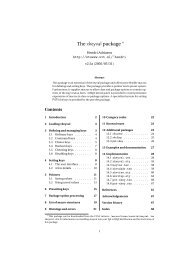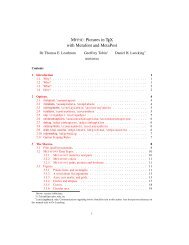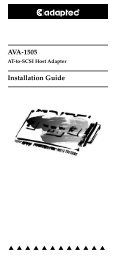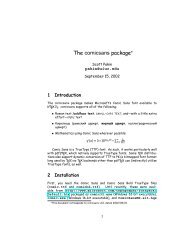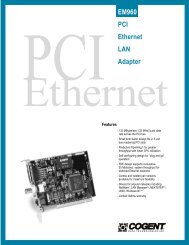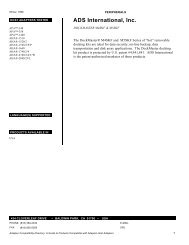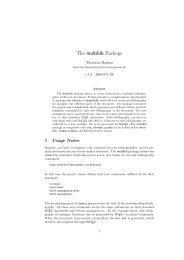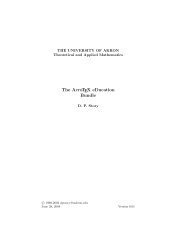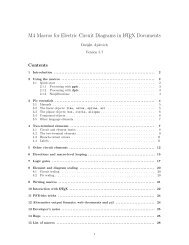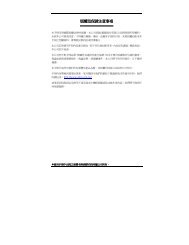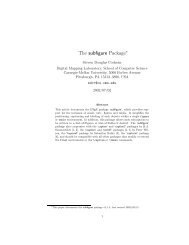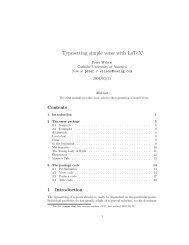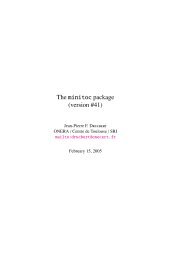The hanging package
The hanging package
The hanging package
You also want an ePaper? Increase the reach of your titles
YUMPU automatically turns print PDFs into web optimized ePapers that Google loves.
<strong>The</strong> <strong>hanging</strong> <strong>package</strong> ∗Peter Wilson †Catholic University of AmericaNow at peter.r.wilson@boeing.com2004/04/22Abstract<strong>The</strong> <strong>hanging</strong> <strong>package</strong> provides facilities for defining <strong>hanging</strong> paragraphsand <strong>hanging</strong> punctuation.Contents1 Introduction 12 <strong>The</strong> <strong>hanging</strong> <strong>package</strong> 22.1 Hanging paragraphs . . . . . . . . . . . . . . . . . . . . . . . . . . 22.2 Hanging punctuation . . . . . . . . . . . . . . . . . . . . . . . . . . 23 <strong>The</strong> <strong>package</strong> code 33.1 Hanging paragraphs . . . . . . . . . . . . . . . . . . . . . . . . . . 43.2 Hanging punctuation . . . . . . . . . . . . . . . . . . . . . . . . . . 41 IntroductionSome authors may wish to use <strong>hanging</strong> paragraphs in their documents. Normallyonly the first line of a paragraph is indented. A <strong>hanging</strong> paragraph is a paragraphlike this one where lines other than the first have indentation. Other authorsmight wish to use <strong>hanging</strong> punctuation. In this style of typesettingpunctuation marks that come at either the start or end of a line are typesetoutside the normal text block.<strong>The</strong> <strong>hanging</strong> <strong>package</strong> provides facilities for both <strong>hanging</strong> paragraphs and <strong>hanging</strong>punctuation.This manual is typeset according to the conventions of the L A TEX docstriputility which enables the automatic extraction of the L A TEX macro sourcefiles [GMS94].∗ This file (<strong>hanging</strong>.dtx) has version number v1.2a, last revised 2004/04/22.† After May 2004 at pandgwilson at earthlink dot net1
Section 2 describes the usage of the <strong>package</strong>. Commented source code for the<strong>package</strong> is in Section 3.2 <strong>The</strong> <strong>hanging</strong> <strong>package</strong>\hangparahangparashangpunct2.1 Hanging paragraphs<strong>The</strong> <strong>hanging</strong> <strong>package</strong> provides a command for producing a single <strong>hanging</strong> paragraphand an environment for typesetting a series of <strong>hanging</strong> paragraphs.<strong>The</strong> command \hangpara{〈indent〉}{〈afternum〉} placed at the start of a paragraphwill cause it to be typeset as a <strong>hanging</strong> paragraph.<strong>The</strong> 〈indent〉 argument specifies the amount of indentation. <strong>The</strong> value mustbe a length. A positive value will indent the left hand side of the paragraph anda negative value will cause the right hand side of the text to be indented.<strong>The</strong> 〈afternum〉 argument controls the number of lines that will be indented.<strong>The</strong> value can be a positive or negative integer, say N. If N > 0 then linesafter the N th line (i.e., lines N + 1 and onwards) will be indented. If N < 0 thenthe first N lines will be indented. This paragraph has been typeset according to thespecification \hangpara{3em}{-2} whereas the first paragraph in the Introductionwas typeset according to \hangpara{3em}{2}.A word of caution: <strong>The</strong>re must be no linebreak between the \hangpara commandand the start of the paragraph text. Either put the command at the startof the paragraph text, or on the previous line with a following %.<strong>The</strong> hangparas environment can be used for typeseting a sequence of <strong>hanging</strong>paragraphs. <strong>The</strong> environment takes the same two arguments as the \hangparacommand. That is,\begin{hangparas}{〈indent〉}{〈afternum〉}.Another word of caution: <strong>The</strong> hangparas environment changes the definitionof \everypar and may have unexpected interactions with any enclosed commandsor environments that also change \everypar. If this does happen, then use the\hangpara command for the problematic paragraph(s) instead of the hangparasenvironment.2.2 Hanging punctuationText within the hangpunct environment will be typeset with <strong>hanging</strong> punctuation.Personally, I think that this is more of a curiosity than anything else. Othersdisagree and think it is an essential part of fine typography.Use of the environment may have unpleasant side effects as the punctuationcharacters are made active (i.e., they act as commands rather than as glyphs).<strong>The</strong> <strong>hanging</strong> punctuation characters are left and right single and double quotes(‘’), period (or full stop) (.), exclamation mark (!), question mark (?), colon andsemicolon (:;), and the comma (,).If you really care about <strong>hanging</strong> punctuation, Hàn Th´ê Thành’s pdf(La)TeXhas built in support via \pdfprotrudechars. This is implemented in the pdfTeX2
program itself [Tha00], so is robust. <strong>The</strong> pdf(La)TeX system is available fromCTAN but the latest version, if not on CTAN, can be obtained from ftp://ftp.cstug.cz/pub/tex/lo9cal/cstug/thanh/pdftex.<strong>The</strong> <strong>package</strong> takes several options which stop punctuation characters frombeing hung. <strong>The</strong> available options include:notcomma don’t hang the comma (,)notperiod don’t hang the period (full stop) (.)notquote don’t hang any quote marks (‘ ‘‘ ’’ ’)notquery don’t hang the question mark (?)notexcl don’t hang the exclamation mark (!)notcolon don’t hang the colon (:)notscolon don’t hang the semicolon (;)If none of these options are given then all the available punctuation marks will behung.<strong>The</strong>re is one other option:fine <strong>The</strong> default settings for the amount of punctuation hang correspond to thosegiven by Donald Knuth in the TeXbook [Knu84], and are independent of thelocal font in use (use pdfLaTeX for font-dependent settings). Stefan Ulrich 1suggested a less aggresive hang, which is provided by the fine option. Thisoption also stops <strong>hanging</strong> question and exclamation marks.\nhpt\nhlq\nhrqIf a non-<strong>hanging</strong> period, or left or right quote character is required in it’scharacter form within the hangpunct environment, then respectively the \nhpt,\nhlq and \nhrq commands can be used. For example, if a length is to be changedyou cannot write:\setlength{\mylength}{2.76cm}. Instead you must code this as:\setlength{\mylength}{2\nhpt76cm}.3 <strong>The</strong> <strong>package</strong> codeAnnounce the name and version of the <strong>package</strong>, which requires L A TEX 2ε.1 〈∗usc〉2 \NeedsTeXFormat{LaTeX2e}3 \ProvidesPackage{<strong>hanging</strong>}[2001/03/15 v1.2 <strong>hanging</strong> paragraphs and punctuation]1 Private email on 2001/03/14 (ulrich@cis.uni-muenchen.de).3
3.1 Hanging paragraphs\hangparahangparas<strong>The</strong> command for a single <strong>hanging</strong> paragraph. Just <strong>package</strong> up the TEX \hang...commands, together with \noindent to switch off any existing \parindent indentation.4 \newcommand{\hangpara}[2]{\hangindent#1\hangafter#2\noindent}<strong>The</strong> environment for typesetting multiple <strong>hanging</strong> paragraphs. It takes the samearguments as the \hangpara command. At the start, set the paragraph indent tozero, then change \everypar to \hangpara. At the end of the environment makesure that the last paragraph was finished via \par, otherwise the user would haveto leave a blank line or use \par explicitly.5 \newenvironment{hangparas}[2]{\setlength{\parindent}{\z@}6 \everypar={\hangpara{#1}{#2}}}{\par}3.2 Hanging punctuation<strong>The</strong> code for <strong>hanging</strong> punctuation is based on the Dirty Tricks example on page395 of the TEXbook [Knu84].I made an experimental attempt to include <strong>hanging</strong> hyphens, but this broke toomany other things all over the place to be of practical use. I believe Knuth whenhe says that <strong>hanging</strong> hyphens require a font with a zero-width hyphen. I thinkthat the basic problem is that the ‘-’ character, as input, represents both a hyphenand a minus sign; diddling with a hyphen means that the minus sign is similarlydiddled. This <strong>package</strong> is meant to be independent of the font, and following Knuth,providing a <strong>hanging</strong> hyphen is font-dependent. Fortunately, most of the time TEXmanages to avoid hyphens at line ends.Stefan Ulrich (ulrich@cis.uni-muenchen.de) pointed out that the EC fontsinclude a hyphen with a smaller, but non-zero, width. Using this then the lastnon-hyphen character at the end of a hyphenated line will be a little closer to themargin. To use the smaller EC hyphen, Stefan suggested doing:\use<strong>package</strong>[T1]{fontenc}\hyphenchar\font=127\ifh@ngcomma\ifh@ngfstop\ifh@ngquote\ifh@ngquery\ifh@ngexcl\ifh@ngcolon\ifh@ngscolon\ifh@ngfineWe need some booleans for the options.7 \newif\ifh@ngcomma \h@ngcommatrue8 \newif\ifh@ngfstop \h@ngfstoptrue9 \newif\ifh@ngquote \h@ngquotetrue10 \newif\ifh@ngquery \h@ngquerytrue11 \newif\ifh@ngexcl \h@ngexcltrue12 \newif\ifh@ngcolon \h@ngcolontrue13 \newif\ifh@ngscolon \h@ngscolontrue14 \newif\ifh@ngfine \h@ngfinefalseNow do the options.15 \DeclareOption{notcomma}{\h@ngcommafalse}4
16 \DeclareOption{notperiod}{\h@ngfstopfalse}17 \DeclareOption{notquote}{\h@ngquotefalse}18 \DeclareOption{notquery}{\h@ngqueryfalse}19 \DeclareOption{notexcl}{\h@ngexclfalse}20 \DeclareOption{notcolon}{\h@ngcolonfalse}21 \DeclareOption{notscolon}{\h@ngscolonfalse}22 \DeclareOption{fine}{\h@ngfinetrue}23 \ProcessOptions\relax24 \ifh@ngfine25 \h@ngqueryfalse \h@ngexclfalse26 \fi\h@ngcommawd\h@ngfstopwd\h@ngquotewd\h@ngdquotewd\h@ngquerywd\h@ngexclwd\h@ngcolonwd\h@ngscolonwd\h@ngallowhyphens\nhpt\nhlq\nhrqWe need some lengths for kerning for each punctuation mark that might be hung.<strong>The</strong>se are set to the width of the character.27 \newlength{\h@ngcommawd} \settowidth{\h@ngcommawd}{,}28 \newlength{\h@ngfstopwd} \settowidth{\h@ngfstopwd}{.}29 \newlength{\h@ngquotewd} \settowidth{\h@ngquotewd}{‘}30 \newlength{\h@ngdquotewd} \settowidth{\h@ngdquotewd}{‘‘}31 \newlength{\h@ngquerywd} \settowidth{\h@ngquerywd}{?}32 \newlength{\h@ngexclwd} \settowidth{\h@ngexclwd}{!}33 \newlength{\h@ngcolonwd} \settowidth{\h@ngcolonwd}{:}34 \newlength{\h@ngscolonwd} \settowidth{\h@ngscolonwd}{;}<strong>The</strong>se values are changed if the fine option is given. <strong>The</strong> following is by courtesyof Stefan Ulrich.35 \ifh@ngfine36 \setlength{\h@ngcommawd}{0.35\h@ngcommawd}37 \setlength{\h@ngfstopwd}{0.30\h@ngfstopwd}38 \setlength{\h@ngquotewd}{0.30\h@ngquotewd}39 \setlength{\h@ngdquotewd}{0.35\h@ngdquotewd}40 \setlength{\h@ngcolonwd}{0.20\h@ngcolonwd}41 \setlength{\h@ngscolonwd}{0.20\h@ngscolonwd}42 \fi43An incantation to be used to allow hyphenation in a ‘word’ beginning with a quotemark. 244 \newcommand{\h@ngallowhyphens}{\nobreak\hskip\z@skip}As the punctuation is going to be made active, we need commands for some ofthe characters when they will be used in constants.45 \newcommand{\nhpt}{.}46 \newcommand{\nhlq}{‘}47 \newcommand{\nhrq}{’}2 Hubert Gaesslein (hubertjg@virtualphotonics.cm) pointed out that the definition ofh@ngallowhyphens should end with z@skip rather than my original z@, in case it was used insituations I hadn’t thought of.5
\h@nglqq\h@ngrqq\h@ngrquote\h@nglquote\h@ngcomma\h@ngfstop\h@ngquery\h@ngexcl\h@ngcolon\h@ngscolonCommands for punctuation with kerning.48 \newcommand{\h@nglqq}{‘‘}49 \newcommand{\h@ngrqq}{’’}50 \newcommand{\h@ngrquote}{’\kern-\h@ngquotewd\kern\h@ngquotewd}51 \newcommand{\h@nglquote}{\ifhmode\kern\h@ngquotewd\vadjust{}\else\leavevmode\fi52 \kern-\h@ngquotewd‘\h@ngallowhyphens}53 \newcommand{\h@ngcomma}{,\kern-\h@ngcommawd\kern\h@ngcommawd}54 \newcommand{\h@ngfstop}{.\kern-\h@ngfstopwd\kern\h@ngfstopwd}55 \newcommand{\h@ngquery}{?\kern-\h@ngquerywd\kern\h@ngquerywd}56 \newcommand{\h@ngexcl}{!\kern-\h@ngexclwd\kern\h@ngexclwd}57 \newcommand{\h@ngcolon}{:\kern-\h@ngcolonwd\kern\h@ngcolonwd}58 \newcommand{\h@ngscolon}{;\kern-\h@ngscolonwd\kern\h@ngscolonwd}\activatepunct At this point we make the punctuation characters active. 3Activate the punctuation characters, leaving the left quote till last.59 \def\activatepunct{%60 \ifh@ngcomma \catcode‘\,=\active \fi61 \ifh@ngfstop \catcode‘\.=\active \fi62 \ifh@ngquote \catcode‘\’=\active \fi63 \ifh@ngquery \catcode‘\?=\active \fi64 \ifh@ngexcl \catcode‘\!=\active \fi65 \ifh@ngcolon \catcode‘\:=\active \fi66 \ifh@ngscolon \catcode‘\;=\active \fi67 \ifh@ngquote \catcode‘\‘=\active \fi68 }Define the simple punctuation macros in terms of the respective \h@ng... commands,using \gdef as they are instantiated in a group.69 \begingroup70 \activatepunct71 \ifh@ngcomma \gdef,{\h@ngcomma} \fi72 \ifh@ngfstop \gdef.{\h@ngfstop} \fi73 \ifh@ngquery \gdef?{\h@ngquery} \fi74 \ifh@ngexcl \gdef!{\h@ngexcl} \fi75 \ifh@ngcolon \gdef:{\h@ngcolon} \fi76 \ifh@ngscolon \gdef;{\h@ngscolon} \fiLife is more complicated for quote marks as they have to check for ligatures.77 \ifh@ngquote78 \gdef’{\futurelet\next\h@ngrqtest}79 \gdef‘{\futurelet\next\h@nglqtest}\h@ngrqtest\h@nglqtest\h@ngrquotes\h@nglquotesCommands for left and right quotes ligature tests.80 \gdef\h@ngrqtest{\ifx\next’\let\next=\h@ngrquotes\else\let\next=\h@ngrquote\fi\next}81 \gdef\h@nglqtest{\ifx\next‘\let\next=\h@nglquotes\else\let\next=\h@nglquote\fi\next}82 \gdef\h@ngrquotes’{\h@ngrqq\kern-\h@ngdquotewd\kern\h@ngdquotewd}3 My thanks to Harald Hanche-Olsen hanche@math.ntnu.no for showing me how to do thisinstead of my initial hack of putting all the following code into a file to be input by the environment.6
83 \gdef\h@nglquotes‘{\ifhmode\kern\h@ngdquotewd\vadjust{}\else\leavevmode\fi84 \kern-\h@ngdquotewd\h@nglqq\h@ngallowhyphens}85 \fiFinally, end the group started earlier.86 \endgrouphangpunct<strong>The</strong> definition of the <strong>hanging</strong> punctuation environment is now very simple. It justcalls \activatepunct.87 \newenvironment{hangpunct}{\activatepunct}{}<strong>The</strong> end of this <strong>package</strong>.88 〈/usc〉References[GMS94] Michel Goossens, Frank Mittelbach, and Alexander Samarin. <strong>The</strong> LaTeXCompanion. Addison-Wesley Publishing Company, 1994.[Knu84][Tha00]Donald E. Knuth. <strong>The</strong> TeXbook. Addison-Wesley Publishing Company,1984.Hàn Th´ê Thành. Micro-typographic extensions to the TeX typesettingsystem. Dissertation. Masaryk University Brno, Faculty of Informatics,October 2000. (Available as http://www.fi-muni.cz/~thanh/download/thesis.pdf)IndexNumbers written in italic refer to the page where the corresponding entry is described;numbers underlined refer to the code line of the definition; numbers inroman refer to the code lines where the entry is used.Symbols\! . . . . . . . . . . . . . . 64\, . . . . . . . . . . . . . . 60\: . . . . . . . . . . . . . . 65\; . . . . . . . . . . . . . . 66\? . . . . . . . . . . . . . . 63\‘ . . . . . . . . . . . . . . 67A\activatepunct 59, 70, 87\active . . . . . . . . 60–67C\catcode . . . . . . . 60–67Eenvironments:hangparas . . . . . 2, 5hangpunct . . . . . 2, 87F\futurelet . . . . . 78, 79H\h@ngallowhyphens .. . . . . . . 44, 52, 84\h@ngcolon . . . . . 48, 75\h@ngcolonfalse . . . 20\h@ngcolontrue . . . . 12\h@ngcolonwd . . . . 27, 57\h@ngcomma . . . . . 48, 71\h@ngcommafalse . . . 15\h@ngcommatrue . . . . . 7\h@ngcommawd . . . . 27, 53\h@ngdquotewd 27, 82–84\h@ngexcl . . . . . . 48, 74\h@ngexclfalse . . 19, 25\h@ngexcltrue . . . . . 11\h@ngexclwd . . . . . 27, 56\h@ngfinefalse . . . . 14\h@ngfinetrue . . . . . 22\h@ngfstop . . . . . 48, 72\h@ngfstopfalse . . . 16\h@ngfstoptrue . . . . . 87
\h@ngfstopwd . . . . 27, 54\h@nglqq . . . . . . . 48, 84\h@nglqtest . . . . . 79, 80\h@nglquote . . . . . 48, 81\h@nglquotes . . . . . . 80\h@ngquery . . . . . 48, 73\h@ngqueryfalse . 18, 25\h@ngquerytrue . . . . 10\h@ngquerywd . . . . 27, 55\h@ngquotefalse . . . 17\h@ngquotetrue . . . . . 9\h@ngquotewd . 27, 50–52\h@ngrqq . . . . . . . 48, 82\h@ngrqtest . . . . . 78, 80\h@ngrquote . . . . . 48, 80\h@ngrquotes . . . . . . 80\h@ngscolon . . . . . 48, 76\h@ngscolonfalse . . 21\h@ngscolontrue . . . 13\h@ngscolonwd . . . 27, 58\hangafter . . . . . . . . 4\hangpara . . . . . . 2, 4, 6hangparas (environment). . . . . . 2, 5hangpunct (environment). . . . . 2, 87I\ifh@ngcolon . . 7, 65, 75\ifh@ngcomma . . 7, 60, 71\ifh@ngexcl . . . 7, 64, 74\ifh@ngfine . . . 7, 24, 35\ifh@ngfstop . . 7, 61, 72\ifh@ngquery . . 7, 63, 73\ifh@ngquote 7, 62, 67, 77\ifh@ngscolon . 7, 66, 76N\newif . . . . . . . . . . 7–14\next . . . . . . . . . . 78–81\nhlq . . . . . . . . . . . 3, 45\nhpt . . . . . . . . . . . 3, 45\nhrq . . . . . . . . . . . 3, 45P\parindent . . . . . . . . 5\ProvidesPackage . . . 3V\vadjust . . . . . . . 51, 83Z\z@skip . . . . . . . . . . 448



